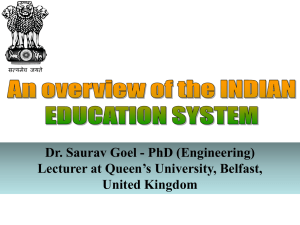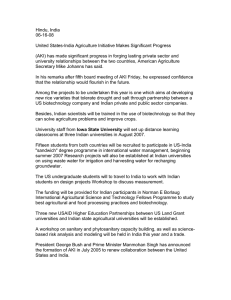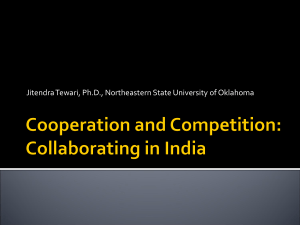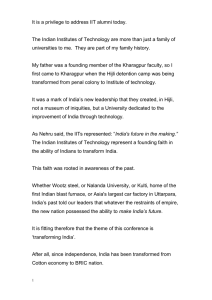It is an honour to join the CII at your... conference. This is my second visit to the centre and my...
advertisement
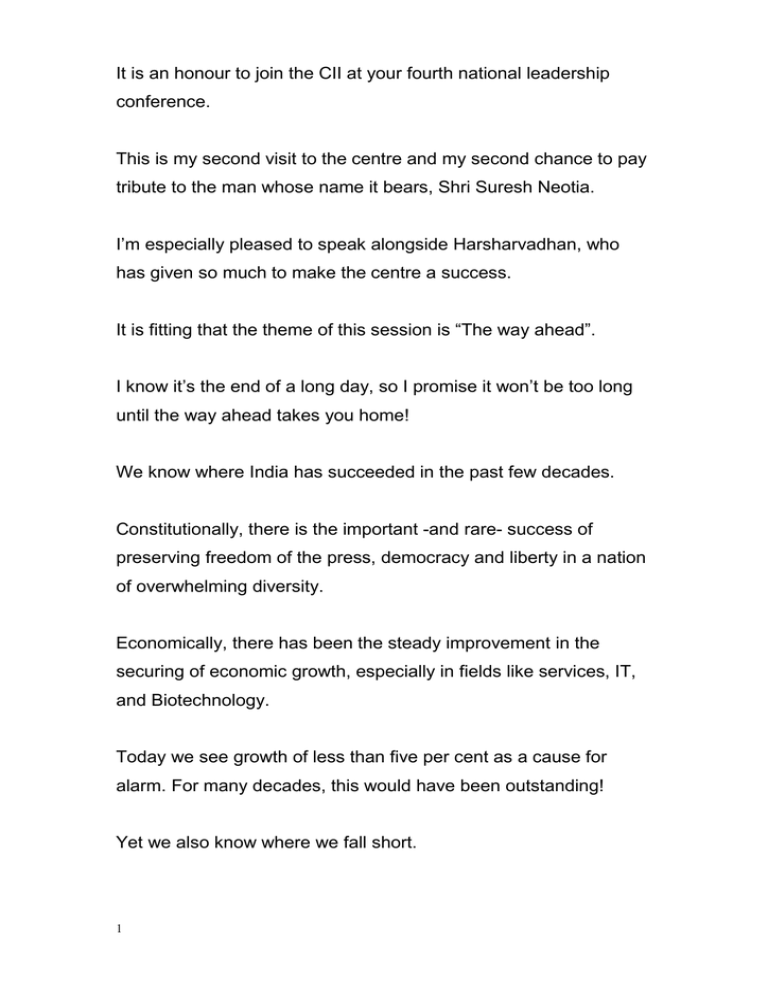
It is an honour to join the CII at your fourth national leadership conference. This is my second visit to the centre and my second chance to pay tribute to the man whose name it bears, Shri Suresh Neotia. I’m especially pleased to speak alongside Harsharvadhan, who has given so much to make the centre a success. It is fitting that the theme of this session is “The way ahead”. I know it’s the end of a long day, so I promise it won’t be too long until the way ahead takes you home! We know where India has succeeded in the past few decades. Constitutionally, there is the important -and rare- success of preserving freedom of the press, democracy and liberty in a nation of overwhelming diversity. Economically, there has been the steady improvement in the securing of economic growth, especially in fields like services, IT, and Biotechnology. Today we see growth of less than five per cent as a cause for alarm. For many decades, this would have been outstanding! Yet we also know where we fall short. 1 In recent decades it was was relatively easy to do well. You could get a license, or get an MBA, some contacts and a contract to supply a defined service to a corporation. So we had a lot of products and services made in India, but few made BY India. With a weak global economy creating spare capacity in the “developed” economies, the era of “growth through outsourcing” has ended. Growth is stuttering, partly because of global weakness, but also because investment is too low, our manufacturing and infrastructure is weak, our decision-making stagnant. These are long term problems that cannot be solved by the passing of a law or the removal of a regulation. India must now find “a new way ahead”. We have to find a long term path to growth. I believe investing in technological innovation is central to India’s next transformation: the shift to general prosperity. It’s always harder to build a future through innovation, research and technology than through temporary trading advantage from lower costs, but it is much more permanent. 2 To make this happen, we need Industry to create the leaders, the change-makers, the creative sparks who will drive India’s next transformation. Why do I believe that a combination of emphasising innovation through technology, through developing a cadre of industrial and technologically minded leaders can transform India? Because it already has. A few years back, Kalpana Kochhar argued in a seminal paper for the IMF that a key reason for India’s unusually structured economic success after liberalisation was the existence of a small, but highly capable services and manufacturing workforce. Dr Kochhar showed that India had “a far greater investment in tertiary education for a country of its... income” which created “capabilities that did not exist in the typical poor country” allowing India to “follow a different growth path from other countries”. This matters a great deal, because as we all know India does not even come close to matching China on traditional measures like foreign investment, infrastructure or manufacturing facilities. I visit China regularly, and see magnificent bridges, rapid-transport systems, fast-built special economic zones. In India, we have teeming cities, crumbling roads and drawn-out political struggles over a few hundred acres for a factory. 3 I’m sure all this has been mentioned many times today. It’s almost compulsory to make the comparison, and it’s obvious because it’s true. We sit by the sluggish Hooghly and envy the flow of investment up the Pearl and Yangtze rivers. We can complain about this, and should try to change what we can, but in the meantime, we must also make the most of any chance we have to take a “different path to growth”. The key lies in what Kochhar called the “creation of capability”. This is the industrial leadership ability to develop and exploit new ideas that will produce something - whether a product or a servicebetter than anywhere else in the world. In turn, this capability drives growth, and attracts investment, creating a positive cycle. The foundation for that capability is education. Education is in some ways the true Indian passion, Perhaps even more a true Bengali passion! My two colleagues on this panel, to take just a small example, have degrees from Harvard and Oxford. I should imagine there are few newspaper editors in the World who are also globally recognised academic authorities! 4 This culture of learning encompasses the great Bengali poets like Tagore to scientists like Sir Jagadish Bose and Prafulla Chandra Roy. These pathfinders sprang from the strength of our educational system, which developed successive generations of leaders whether it be Bose’s Presidency college, Indra Nooyi’s Indian Institute of Management Calcutta or my own alma mater, IIT Kharagpur. That early educational strength drove the early Industrial and Business success of Bengal. It is no coincidence that Kulti is the home of the first Indian blast furnace, while Uttarpara was the site of Asia's largest car factory. Today, Technology research institutes around the world, whether MIT, Caltech, Imperial College London, or my own WMG, create ecologies of innovation where solutions are found to problems from natural gas extraction, to computing, to materials science and nano-technology. In turn, these support the economic growth of their communities and nations. Today, many Indian leaders know how important an emphasis on education is. 5 Examples of the centrality of domestic innovation can be found across Indian business. Would Tata Motors have had the ability to design the Nano if it had not developed the Research and Development capability to design the Indica first? Would Wipro have developed it's world leading software capability without employees who had learned how to build and programme computers from the inside out? Would Mahindra and Mahindra been able to develop the Scorpio SUV without leaders like Dr Pawan Goenka, a graduate of IIT Kanpur with global experience? Further, with India’s history of innovation in fields from mathematics to Steel, the cultural value attached to education, the strength of the Indian intellectual diaspora, it is within India’s reach to be a global giant in innovation and technology research. This will drive Indian growth in the long term. However, we must be frank. For all our intellectual achievements, for all the graduates doing inspiring work, for all the engineers working overseas, India is far from where she needs to be. 6 Here in Bengal, we have everything - natural resources, location, population, intellectual capital, needed for success - but we lack the ability to put these things together for the common good. At the top, India has three of the world’s top four hundred Universities. China has nine. Add to that five in Hong Kong, and you see a research and innovation gap emerging, alongside infrastructure and manufacturing gaps. So we must press ahead with the World Class Innovation Universities the centre has proposed. But our universities must change too. World class institutions need the best faculty, and to teach students with the methods of the world’s best. That means financing levels must increase, and investment in facilities must jump up. Let me put it simply. You can’t expect MIT results on nursery school budgets. If we want Universities to transform India, we need to transform Universities, from the fee and loan system to teaching styles. We also need our “innovation universities” to truly look outwards. 7 That means our new innovation universities must be better integrated into the challenges facing the economy and their communities. Chief among these is the need to expand technical and vocational education to the Indian masses. The World Bank tells us that India needs one point two million additional teachers just to meet the needs of the RTE act. Yet less than ten per cent of applicants pass the Teacher eligibility tests. So how can we educate the next generation of children at the level we need? Only through technological innovation. As A V Banerjee wrote in the Journal of Monetary economics, “The natural solution … is to scale up the number of people that can be reached through a single good teacher by using... technological means” Similarly, the difficulties facing the manufacturing sector in India shows the need for universities to help develop India’s manufacturing sector, another huge challenge, especially when we consider the need to expand job creation rapidly. To achieve this we need more top class private universities, we need greater industry-academic research collaboration and we 8 need a rapid expansion of vocational education partnerships between universities and industry. Whether in virtual car design, low carbon energy, nano-materials or data security and processing, the next generation of Indian businesses need research and technical training facilities to put their employees at the cutting edge. This means there is a vital leadership role for industry, one both altruistic and self interested. High-skill employers have a direct interest in liberating the talents of their workforce, from shop floor to research lab. Universities are well placed to help deliver this, both in the workplace and on campus. Finally, whether through student loan repayment or direct research funding, employers can provide the stable income research and vocational education in India desperately needs to expand. All this brings me back to the value of leadership. When I spoke here two years ago, I spoke about the value of leaders thinking for the long term and focussing on their responsibilities to others. It’s sometimes easy, in good times, to enjoy ostentation and wealth and to forget about responsibility. 9 Yet to show true leadership, the next generation of Indian Industrialists need to think for the long term, about creating real value, about their responsibility to society. Nowhere is this more true than in the Industrial relationship with education. The very first task is to demonstrate that we can stop the waste of talent that comes from ignorance. We see all around us, from industrial giants such as Tata to new giants like Wipro, to the social entrepreneurs and green growth advocates of SELCO, how the common threads of education and innovation combine to the benefit of business and community. So how much have we all lost in the crores of hopefuls who did not get a chance to show how they too could succeed? It is the responsibility of those who have done well out of the past transformations of India to share more widely the capabilities which made them successful, preparing others for the next transformation. By doing so, we can liberate the capabilities and innovation of the Indian people. This is thinking for the long term. If we do this, we will all be able to profit together. Now we must meet the challenge of expanding India’s world class institutions and using our foundation of technical innovation to share that capability widely. 10 If we do this we will stay true to the values of the visionaries who led India from independence to global giant, and will guide the nation through the greater transformations to come. That is a prize worth fighting for. 11
